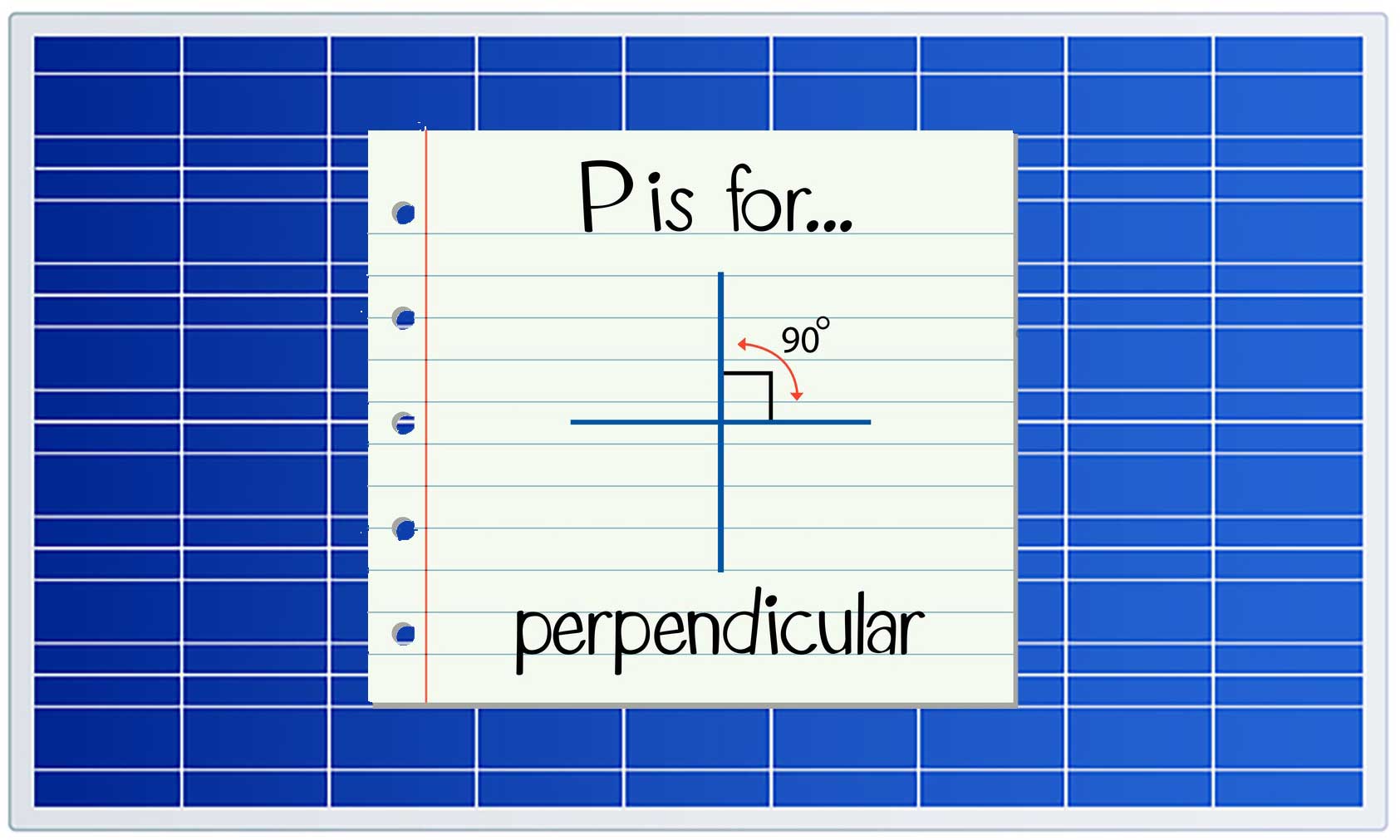
Are vertical solar panels the best orientation for new Australian solar farms?
Last week I wrote about double glass bifacial panels that are able to use light coming from the front and behind, while on Christmas Eve I mentioned large scale solar farms are taking off in Australia. Because it’s the season for togetherness, I thought maybe we could put these two things together and make a bifacial solar farm.
The more I think about it, the more I’m sure it’s a great idea. I’m convinced bifacial solar panels and solar farms go together like pens and pineapples.
Of course, maybe it’s just all the eggnog1 I’m quaffing from my eggnog stein talking, so feel free to try to talk me out of my conviction in the comments, but I think in the near future bifacial panels could — straight up — be the most economical way to build a solar farm.
And I say straight up because that’s how I think they’ll be installed. Standing vertically in a line with one side facing east and the other west, like this:
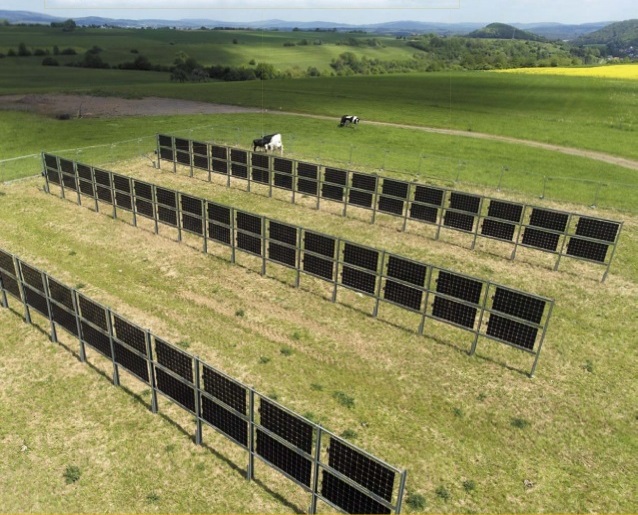
Image Credit: Photon Magazine
When skies are clear this will allow their output to be high soon after sunrise and not long before sunset. These are the times of day when electricity is the most valuable and also the times when solar panels on roofs, even ones facing east or west, are only producing a small fraction of their maximum output.
Rooftop Solar Generates The Most Output In The Middle Of The Day
Australia currently has around 6.8 gigawatts of solar panels, with the majority installed on roofs rather than in solar farms. This comes to an average of 274 watts per person which is enough to generate 1 kilowatt-hour a day for everyone in Australia or 3.5% of our total electricity consumption. Coal generates over 20 times as much, but it wasn’t that long ago coal was generating one million times as much, so solar is not doing too badly. While we don’t generate a large portion of our electricity from the sun at the moment, because its production is concentrated in the middle of the day it is definitely enough to reduce wholesale electricity prices at that time.
The majority of rooftop solar panels face north, or or at least north-ish, but a considerable amount also faces east and west. Despite this, two hours after sunrise or before sunset, rooftop solar will on average produce less than one-quarter the output it achieves around noon. One reason why is because rooftop panels that face east or west are usually at too low an angle to produce high output early or late in the day.
South Australia’s Rooftop Solar Is Off The Charts
South Australia generates perhaps 8% of its electricity from solar energy and this graph from the Australian PV Institute shows the percentage of electricity consumption supplied by rooftop solar power on Christmas day:
As you can see, at almost 46%, South Australia was off the chart. This was a public holiday, but on clear weekdays it’s not unusual for solar power to supply one-third or more of the state’s total electricity consumption around noon. This pushes down the demand for grid electricity during the middle of the day, as you can see on this graph from the Australian Energy Market Operator:
On the left half of this graph, the thin grey line shows how much grid electricity South Australians used on Christmas day. As you can see, the least amount of grid electricity was used around noon2 thanks to rooftop solar power systems. This wasn’t the time of the lowest wholesale electricity spot price, which is represented by the thick, blue, jagged line. But this is affected by a number of things including the price of electricity in Victoria, which has much less solar capacity per person. One thing we do know is wholesale electricity prices during the day are considerably lower than what they would be if there was no solar power.
Solar Electricity Is More Valuable Early In the Morning And Late In The Afternoon
In summer, daytime electricity prices are usually highest late in the afternoon as output from rooftop solar and most existing solar farms falls off while air conditioner use remains high. In winter electricity prices can be high early in the morning as people heat up their homes and business.
Rooftop solar power normally receives a set feed-in tariff regardless of the time of day it supplies electricity to the grid, so low wholesale prices in the middle of the day aren’t an immediate problem3, but for solar farms it’s a tragedy that will only get worse as the large scale portion of our Renewable Energy Target closes to new entrants in 2020 and wholesale electricity prices become the only source of revenue for new solar and wind farms4.
Solar farm developers are well aware electricity prices will only get lower in the middle of the day as more PV capacity is installed. Currently, a popular way of dealing with this problem is for solar farms to put panels on trackers that follow the sun.
Panels On Trackers Have More Constant Ouput
If you look at the yellow line of South Australia’s rooftop solar power output on the graph above and at its 45.86% maximum, you’ll see it was producing less than 10% of its maximum output one hour after sunrise. But if panels are more or less facing directly east, they can generate high output early in the day. As I just mentioned, the way solar farms achieve this is by putting panels on trackers that follow the sun through the day.
The most common and cost effective trackers follow the sun along a single axis. More expensive dual axis trackers can follow the position of the sun through the day and the seasons for even better output. This graph I lifted from a 2011 edition of SolarPro Magazine shows the results from fixed north facing panels and the two different types of trackers:
As you can see the panels with a single axis tracker have a more constant output through the day than the fixed solar panels, or fixed flat plate as they are called on the graph. The dual axis tracker used in this example is an Amonix and it performs very well, both overall and early and late in the day. The benefits of tracking will vary according to location and definitely won’t always be this good, but the graph gives a general idea of results that may be obtained.
While trackers produce more energy and more valuable power, their drawback is they are considerably more expensive than fixed frames. They also have higher operating costs as they require maintenance and repairs and breakdowns can reduce output. Dual axis trackers are particularly expensive to buy and maintain and are rare. But despite the extra cost, being able to produce more electricity early and late in the day is considered worthwhile enough for the majority of new large scale solar in Australia to use single axis tracking.
Output Of Upright Bifacials
Upright Bifacial panels have excellent output early and late in the day but suck around noon, as this simple diagram comparing them to fixed north facing panels shows:
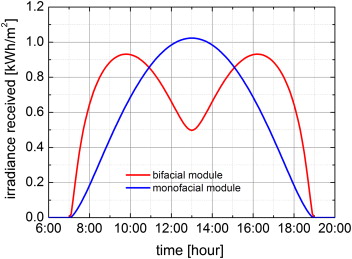
Image Credit: Vertically mounted bifacial photovoltaic modules: A global analysis
But I think that graph is a little boring, so I did a high tech transfer of a more exciting graph from Photon Magazine’s analog cellulose format to solid state digital. It shows the output of an upright bifacial test array in Germany over a summer day:
While a photobomber crashed my graph photography session, you can rest assured no ants5 were harmed in the making of this article. Apart from the one I stood on.
This graph is from a loooong, German, summer day. Our days don’t get that long, so allowances need to be made. But it is clear that upright bifacial panels, facing east and west, can produce around 50% of their maximum output within one hour of sunrise and over two-thirds after two hours. If you look at output of South Australia’s rooftop solar power systems above, you’ll see it’s around 10% of its maximum one hour after sunrise and less than 25% two hours after.
Bifacial panels have one side that performs better than others. In this German example, the good side was facing east, resulting a the highest peak in mid-morning. In Australia, because electricity is more valuable late in the afternoon, we’d place the good side facing west. But it’s possible to mix and match to get the results you want and there is no real technical reason why a bifacial solar panel couldn’t be made to have the same efficiency on both sides. (It’s just easier not to.)
The upright bifacial solar panels clearly have poor performance in the middle of the day when the sun is high overhead, but this is not a big deal as this will be when daytime electricity prices are at their lowest. If it is a problem — for example if they are being used for an off-grid farm or mine — then adding some fixed, north facing, panels will help make up for the middle of the day dip. This graph shows the output of identical capacity fixed north facing panels and upright bifacial panels and their combined output:
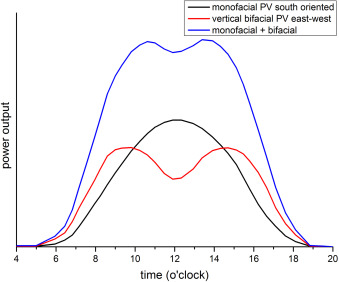
By Our Powers Combined! (Image Credit: Vertically mounted bifacial photovoltaic modules: A global analysis)
Closer To The Equator Isn’t Necessarily Greater
All else equal, upright bifacial solar farms will perform better closer to the equator as the sun will be higher overhead and its light will hit the panels at a more direct angle. But all else is rarely equal and local conditions have a considerable impact on output. Using conservative values for the output of bifacial panels I used PVWatts to estimate how much energy upright east/west bifacial panels would generate over a year as a percentage of the energy produced by north facing fixed solar panels in the same location, taking into account local weather conditions. The results in order of increasing distance from the equator are:
- Darwin 110%
- Brisbane 94% Oakey 109%
- Canberra 102%
- Perth 109%
- Adelaide 107%
While upright bifacial panels did get the best results in Darwin, the most northerly location, almost the same result was obtained 2,100 kilometers south in Perth. Brisbane stands out as the only location where upright bifacial solar panels perform worse than fixed ones. Early morning cloud and late afternoon thunderstorms seem to really take a bite out of their production. Oakey, which is the same distance from the equator as Brisbane but 150 kilometers inland, has a much drier climate and had a very different result.
I’ll stress that these results are estimates only and real life testing will be required to determine the actual figures, but it does suggest location has a major impact on the output of upright bifacial panels.
Upright Bifacials May Need A Lot Of Space Between Rows
A disadvantage of putting bifacial panels upright is a lot of space is needed between rows if you don’t want them to shade each other. In Europe this isn’t necessarily a problem as it can allow a solar farm to continue to be used as a food farm. It is actually common there for countries to have laws against removing land from agricultural use.
In Australia we have a lot more land at a lower price than what’s available in Europe, so using an insignificant portion of it for solar farms is not a pressing problem. But the option of whacking crops or livestock between those panels is still useful, especially since existing transmission lines generally cross farmland rather than trackless desert.
Upright Bifacial Solar Farms May Boost Agricultural Output
The neat thing is, in this country, upright bifacial solar panels are likely to increase agricultural output. This is because, while plants need light to grow, in Australia we have so much goddamn glaring light that a little less is actually a good thing as it increases water availability and reduces heat stress. The rows of panels also cut wind speed, cutting water loss and erosion.
If the bifacial panels are sharing a paddock with cows then they will need to be sturdy or at least wrapped with barbed wire and the panels will need to be raised above cow head scratching height, because cattle are quite destructive. But sheep are pretty much perfect as they are very mild animals. I can get to within 20 or 30 feet of a flock of them before they all pivot in unison to face me and with one voice emit a terrifying, chanting, bleat:
Or They Could Be Put Close Together
Vertical bifacial panels don’t necessarily have to be spaced widely apart. If the available land is limited then they can be put closer together and the hit to production from shading early and late in the day accepted. If the solar panels have panel string optimization it would help limit losses from from shading.
A Single Row Is Also An Option
Of course, one way to avoid shading is to only have one row of panels. That might not sound like enough, but there’s no real reason why it couldn’t be quite long. Barbed wire could even be strung up between the support posts and it could double as a fence. The savings on fence posts won’t amount to much, but every little bit helps.
Wind Is A Problem
Upright bifacial panels can save money on the cost of trackers, but unless the trackers are completely dumb, they can be made to lay the panels horizontally during high winds to reduce wind loading. But this won’t be possible for the upright bifacial solar panels, so their frames and foundations will need to be strong enough to withstand high winds. This will add to the cost of construction and means they’ll be more suitable for inland locations and away from cyclone zones.
The need for frames to be built sturdy enough to handle winds is probably their biggest drawback. This may keep their size small, or in some locations the frames may be large and anchored to bedrock, rather than in dirt or regolith6.
Keeping It Clean
Upright bifacial panels are supposed to remain cleaner than either fixed panels or those on trackers. This makes sense, as dirt and dust should be less likely to land on them. I am concerned that only one side might get a good clean when it rains, but I guess experience will show if this turns out to be a problem.
As with any solar farm, there is a danger that birds will perch above solar panels and poop on them. This will be especially true if the land is used agriculturally and attracts them. But this can be prevented by putting a jagged edge along the top of the panels. This is not meant to cut the birds in half when they land, but merely discourage them from landing in the first place.
Impact Resistance
Hail is a danger to solar panels and they are designed to withstand impacts from the largest hailstones that normally form. Because hail should only ever hit upright panels at an angle, they should be more resistant to hail strikes than traditionally mounted panels. If the wind is ever so strong that hail is not hitting them at an angle, then they’re probably not going to survive anyway. This increased impact resistance means they should definitely be able to survive long term in the field, or it may mean a little bit can be shaved off the cost of the panels by making them slightly weaker.
Double glass panels, including bifacial ones, can be made without frames. This can save on the cost and weight of a panel, but may leave the edge on top vulnerable to being chipped by hailstones, so it may need some protection. Potentially protection with a jagged edge.
The Economics Of Upright Bifacial Solar Farms
Bifacial PV modules are more expensive than conventional solar panels. At the factory gate they currently cost about twice as much per watt of capacity. But this price differential isn’t going to last forever. While they’ll always carry a premium7, once mass produced for use in solar farms rather than being a niche product for carports and Swedish road barriers, their price should fall until it’s little more than the extra cost of a sheet of glass over a plastic backsheet. While a high output, high tech, robot infested production line is incredibly expensive to set up, once production lines are in place to supply solar farms, the cost per unit will fall a long way. As a result, it will definitely not be cheaper to simply stick two conventional panels back to back.
Combined with the durability of double glass solar panels, the low expected price for electricity in the middle of the day, the lack of maintenance required once installed, and the ability to keep land available for farming, I think upright bifacial solar farms may eventually beat tracking solar farms on overall economics. If not everywhere, then in at least some situations. I’m not absolutely certain they’ll take off, but I’m willing to bet at least 20 cents they’ll be trendy in 5 year’s time.
Footnotes
- Non-alcoholic eggnog because I don’t need alcohol to get high. I’m high on life. And prescription drugs. But mainly life. Specifically all the eggs and sugarcane plants that died to make this eggnog. (Yes, an egg is a living thing. Chicken development at no point includes a zombie stage.) ↩
- The times on the graph are Eastern Standard Time and South Australia is half an hour ahead during daylight savings — but it’s close enough. ↩
- Although it can and will lead to lower solar feed-in tariffs in the future. ↩
- A sensible government would introduce policy to make sure large scale renewable development doesn’t crash after 2020 and if you think our current government is going to act sensibly with regard to renewable energy, then all I can say is — Welcome to Australia! I hope you are enjoying your first week here! ↩
- This is not the dreaded Jack Jumper ant of the Adelaide Hills that has a single chromosome and its stings can kill through anaphylactic shock. Fortunately, when I do encounter them I can always outwit them because I have at least twice as many chromosomes. ↩
- Regolith is the middle child between bedrock and soil. Most of Australia skips soil and goes straight to regolith. ↩
- Until I work out how to turn coal into spray on liquid diamond. ↩

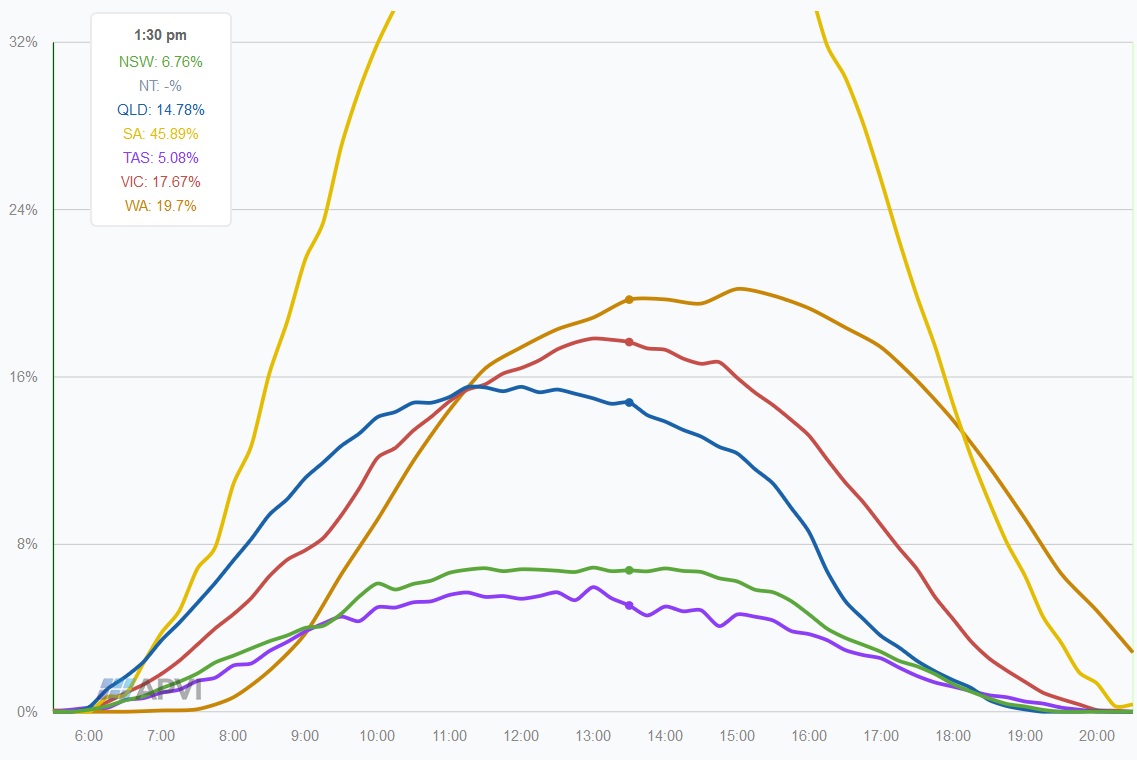
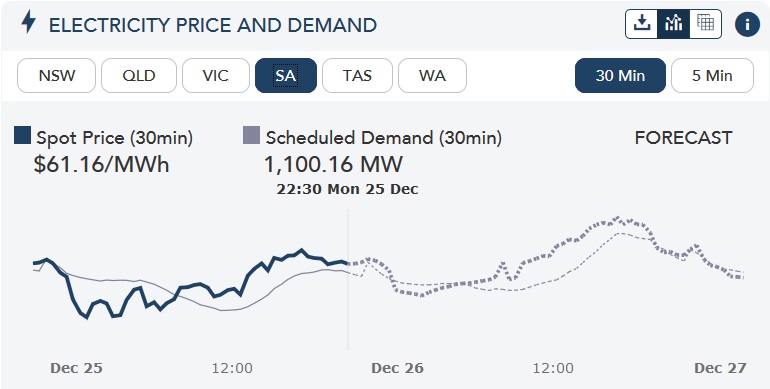
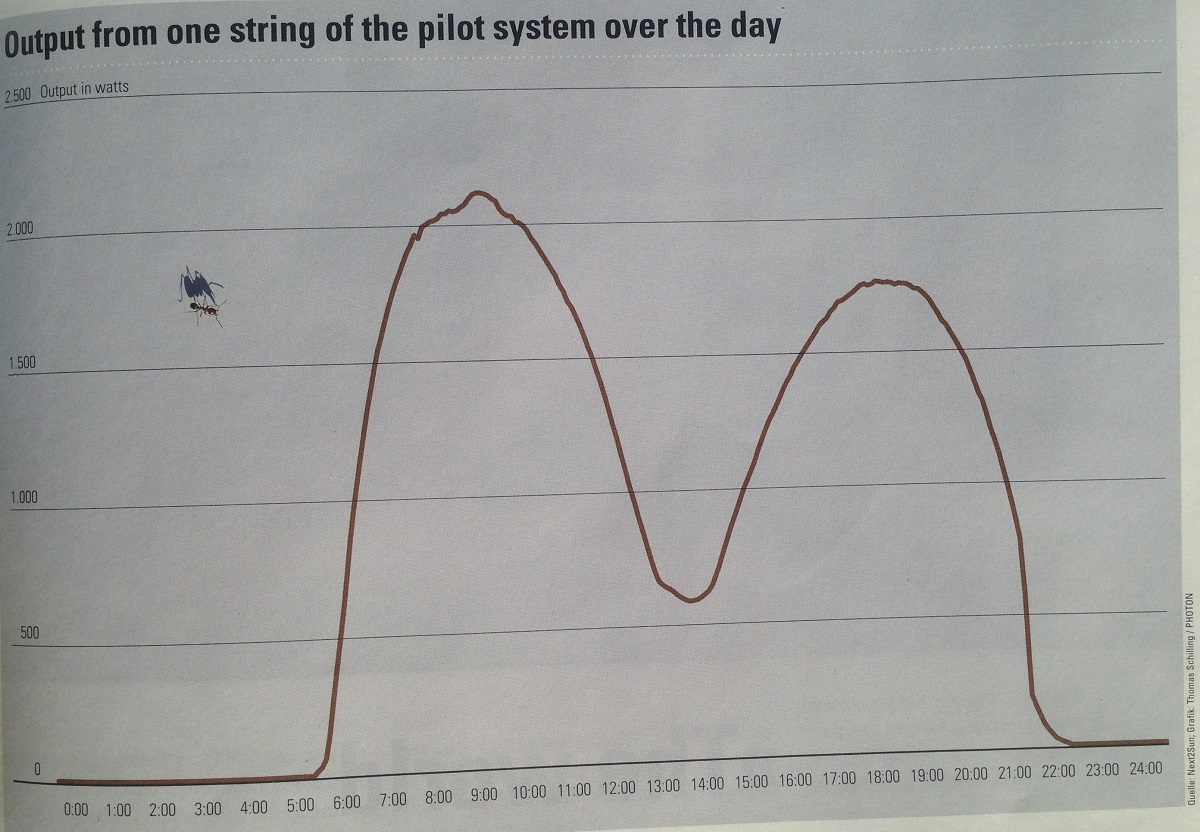
 RSS - Posts
RSS - Posts



Unfortunately an upright panel will suffer somewhat from the latitude effect as well – i.e. at 35 degrees latitude (roughly major Oz capital city latitude) then the old “45 degree reflection problem” would be be a perennial pest (it is difficult to trap as much light at > 45 degree angles). I feel that seasonal variations would be a deal breaker – 52 degrees shift over a year ensures the 45 degrees will happen far too often for efficiency. I reckon two standard slightly offset panels (at say 20 degrees from vertical to optimise daylight power and “your latitude angle” to optimise seasonal variation) would make a massive difference over a calendar year.
It would be interesting to see some real world data with a decent comparison, not just a “one day angled” version.
The more conventional solar power systems feed into a power grid, the more the spot market price for energy falls at solar noon. Therefore, solar electricity generated by vertical systems with bifacial modules becomes “more valuable”.
Furthermore, the production profile of vertical solar plants with bifacial modules thus perfectly complements the production profile of a “normal” solar farm. So even grid operators should love it.
Another big advantage of this concept is the reduced land usage. The spaces between the module rows can still be used. For example for agriculture, as pasture land, grass areas for beekeeping etc.
And as explained in the article systems with bifacial modules generate more energy per installed Wp.
We, the Next2Sun, develop and pursue this concept. Further information under http://www.next2sun.de (unfortunately only in German).
Does anyone know a supplier within Australia for Bifacial Solar Fence mounting systems?
Pauly I would approach Sunlock and Clenergy to see what they have.